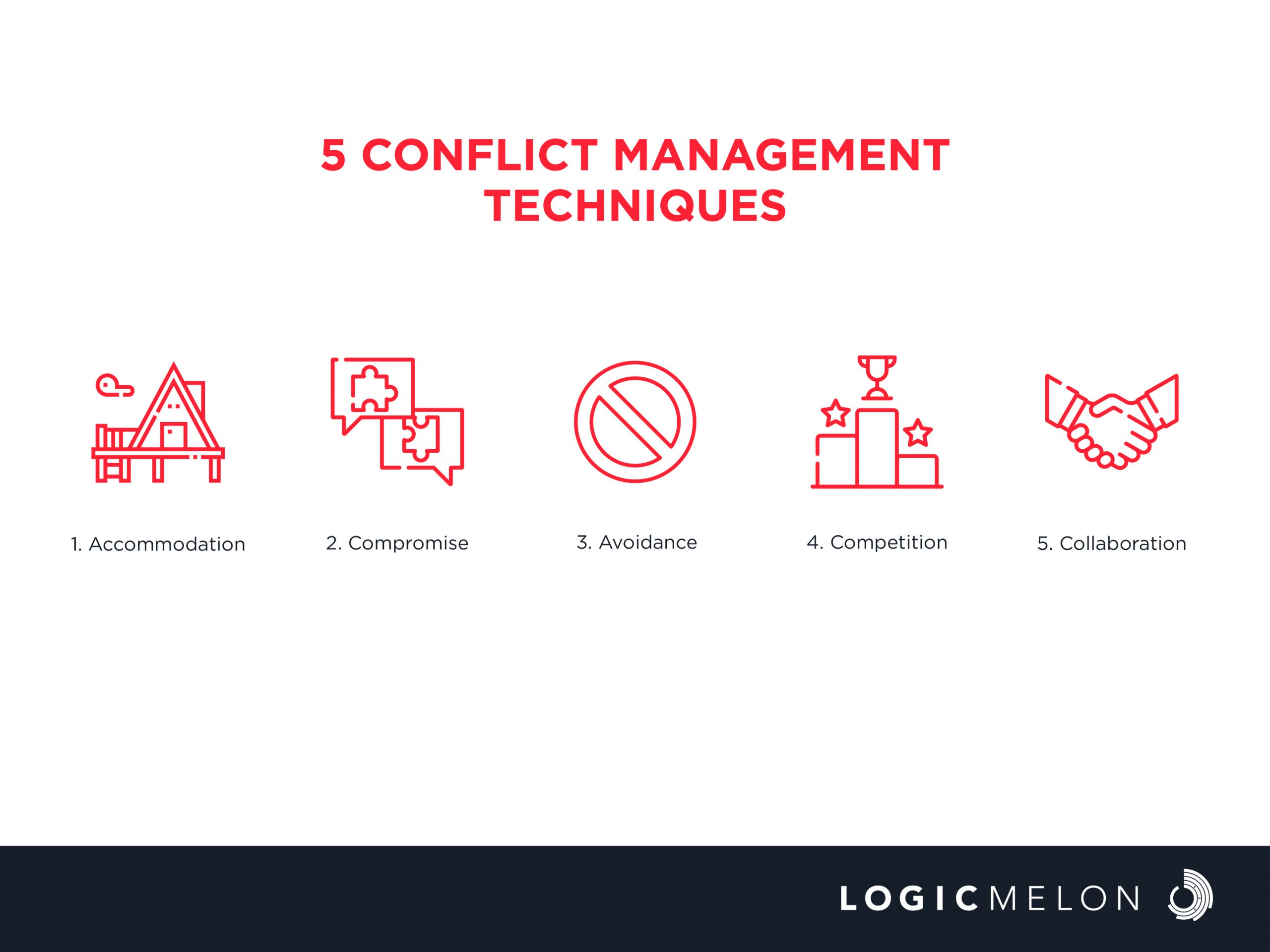5 Conflict Management Techniques
Conflict management techniques are key management skills that have to be followed in the workplace when conflicts happen in the organisation.
Conflict management is the practice of being able to handle conflicts between individuals by sensibly analysing the facts and applying conflict management techniques to resolve the issues.
5 Causes of Conflicts in Organisations
1. Information Conflict
These conflicts arise when people have different or insufficient information and disagree over what data is relevant. Something was missing, incomplete, or ambiguous. Communication breakdown is one of the major reasons for this type of conflict. The lack of communication and the transformation of rigid information create misunderstandings among people.
2. Values Conflict
Values conflicts arise when people try to impose values on others and claims exclusive right to a set of values, and a dispute arises. A clash of personal values leads to conflict. These personal differences are fundamental in causing interpersonal conflict in the organisation and can have a major impact on the emotions of individuals.
3. Interest Conflicts
Interest conflict in the workplace is mainly due to different perspectives, and different mindsets, which causes them to generate different ideas. This is due to the competition faced by the people in the organisation.
4. Relationship Conflicts
These conflicts happen when there is a misperception, strong negative emotions, or poor communication. Relationship conflicts can be addressed by allowing each person uninterrupted time to talk through the issues and can respond to the other person’s concerns.
5. Structural Conflicts
Limited resources or opportunities, as well as organisation structure, promote conflict behaviour. This can be due to the issues arising from money, and resources that affect the organisation in a negative manner. All the activities of individuals concentrate on achieving predetermined goals and if individuals in the same group initiate different goals, this may cause conflict among group members.
Changes in organisation structure may force the person to have different roles and responsibilities to be carried out. Such changes can have an impact on morale and can arise conflicts in the work environment.
5 Conflict Management Techniques

1. Accommodation
The accommodation conflict management technique is used when one party is willing to give up their position to indicate a degree of fairness. An accommodating style is where people wish to encourage others to express their own opinions. The issue or problem is more important to the other party concerned. It is more important to safeguard the relationship, rather than argue about the issue. They focus on resolving the conflict and finding the best solution for the team.
This can work as a catalyst to break the discomfort between the involved parties by creating a feeling of trust and encouraging them to come forward and resolve conflicts.
2. Compromise
This a win-lose situation where the parties involved gain or losses through negotiation and flexibility. The main goal of this approach is to find common ground and maintain the relationship. This solution can be a temporary and not long-lasting solution and parties can take it as a lose-lose situation as both parties may feel that they have lost something in the conflict.
3. Avoidance
This is a lose-lose situation where neither party takes action to address the issues involved in the conflict, meaning that it remains unresolved. Ignoring the whole conflict helps the parties to cool down and spend time apart. A lack of mutual trust among group members can create this conflict. This can generate barriers to achieving goals.
4. Competition
This is a win-lose situation where one party attempts to win the conflict through power and dominance. This conflict management technique is best used when other methods have been tried, in an emergency situation when a quick or immediate decision has to be taken, or in situations where unpopular changes need to be applied and the discussion is not appropriate.
5. Collaboration
It is a win-win solution when both parties cooperate and resolve conflicts by understanding each other’s situation. They focus on resolving the conflict and finding the best solution for the team. When parties from different backgrounds and experiences are involved. When trying to get a source of problems that have continued for a long time.
Frequently Asked Questions
1. What are the five conflict management techniques?
Accommodation or problem-solving, compromise, avoidance, competition and collaboration are the five techniques of conflict management.
2. What are the causes of conflict?
The causes for conflict are information, values, interests, relationships and structure, which is differences in opinion or some kind of disagreement between two or more parties.
3. Why are conflict management techniques important for an organisation?
Proper conflict management techniques are designed to keep disagreements from escalating while continuing to discuss each parties point of view, and eventually reaching a collaborative conclusion. By using these skills, you will be better equipped to learn from these conflicts and can have the ability to resolve any type of conflict that happens in a professional or personal environment.
4. How do you use conflict resolution in the workplace?
To resolve the conflicts that could negatively influence the company’s productivity, we use conflict management techniques. First, try to understand the problem by having interactions with the people involved. Then determine each person’s role in the conflict by analysing the facts of the conflicts and start applying these conflict management strategies to resolve conflicts.
Closing Thoughts
These conflict management techniques, also called conflict resolution techniques, are to be understood by how the issue came to grow in the first place. You must be able to get both parties to agree to what the issue is and discuss needs that are not being met on both sides, ensuring you obtain as much information as possible from each side’s outlook.
So, for effective conflict management, there is a need for creating the right atmosphere, which empowers people to think in their own way, and encourages them to speak their suggestions and opinions without fear. Striking a balance between resolving the conflict to find the decision and maintaining the emotional well-being of the people involved is critical for successful conflict resolution.
LogicMelon
Award-winning recruitment software that will find, attract, hire and analyse the way you want to work. At LogicMelon, we have experienced software recruitment marketing specialists to help you build effective recruitment solutions supported by the best customer service you’ll find anywhere!
Email: sales@logicmelon.com or call LogicMelon (UK) +44 (0) 203 553 3667 (USA) +1 860 269 3089
A Guide to Employee Background Checks
Before welcoming someone into your organisation, remember to request those background checks to ensure they won’t become a liability.
What is Talent Sourcing?
Talent sourcing is the process of identifying candidates and converting them into applicants. Read the blog to know more.
How to Build a Successful Talent Pool
Discover how to create a successful talent pool, the types, and their benefits to achieve long-term objectives in this engaging blog.


